Update: Grayl has just launched the Grayl Ultralight! It has the same great filtration performance and simplicity of the one described here, but at half the weight. If you’re trying to pack light, that’s the one you want. Take a look at a review here. It’s the only thing I would have changed from the original design.
Over the years, one of the items I couldn’t “finish” when constructing the ultimate travel gear setup was a good water bottle. I was on the lookout for something that included a high-quality built-in filter, so I could take it with me all over the world, and I’d never have to worry about tap water quality, or buying bottled water. I’ve gotten stuck in the middle of nowhere with no open shops, and a water filter that’s always with me has come in handy quite a few times.
Unfortunately, options were extremely limited. For several years, despite endless digitally sleuthing, I could find only two sufficient options on the entire planet. Two. Which is why I was happy to finally hear about a third one.
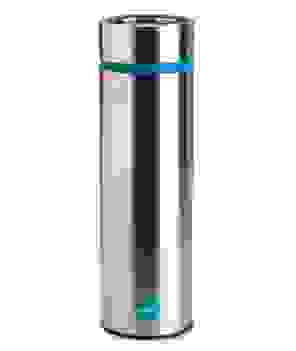
The recently launched Grayl, a stainless steel water purification bottle containing the mechanism entirely within the bottle, was invented by someone who got tired of all the annoying bottles that annoyed me too. But while I sat around complaining, she went out and made one.
While other options require sucking, squeezing, pumping, and other innuendo-laden activities, she wanted something that looked and functioned like a perfectly normal water bottle, with no silly contraptions required.
It turns out they work in my hometown, and I soon found myself at a business meeting, where they gave me a free one. I can only assume it was thanks to my devilish good looks and charm. Perhaps my impeccable comedic timing as well.
I’ve had it for a few days, and have obviously been filling and refilling, disassembling and reassembling, and examining it from every angle, to see how it stacks up against what I’ve used before, and to evaluate whether I’d feel good taking it with me on global adventures. I want just one thing that’ll work wherever. And I think this’ll do it.
Depending on which model you choose, it’s $50-$90 for all-in-one water filtration, in a classy package that’ll work just as well on the trail as it will in a board meeting. I mean, I’m not going to any board meetings, but maybe you are.
And although it seems like a crowded market, it really isn’t. The vast majority of filtered water bottles only filter large particles (thus letting tiny viruses right through), while purifiers only purify the water, killing whatever’s inside (thus letting chemicals right through). Either way, you’re still drinking icky things.
Grayl is one of the very few options that can remove everything, whether it’s chemical, bacterial, viral, or whatever, which is exactly what you’d want in developing countries with suspicious water supplies, along with additional options for more casual use, depending on your situation:
Filter options and cost-effectiveness
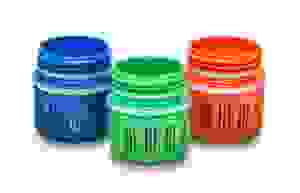
Grayl now offers three different filter types: Tap, Trail, and Travel, color coded for convenience and interchangeable with whichever bottle, providing varying levels of filtration:
- Tap ($15), designed for use at home, which removes chemicals and particles from tap water, making it taste great, averaging $0.10 per liter.
- Trail (discontinued), which removes everything the Tap filter does, along with 99.99% of bacteria, and 99.94% of protozoan cysts (like Giardia and Cryptosporidium), averaging $0.13 per liter.
- Travel ($25, now called the Purifier), which removes everything the Trail filter does, but goes up to 99.9999% of bacteria, 99.999% of protozoan cysts, and additionally removes 99.999% of viruses, averaging $0.26 per liter.
The titles correspond to suggested uses, and it’s nice that you can switch them out as needed, so you could take a Trail filter on a hike, or a Travel filter to Mexico, and switch it with a Tap filter when you get back home, and save the more serious filters for more serious situations.
And while many other purifiers only purify (leaving all the particles in the water) Grayl’s filters actually remove contaminants, so there’s no need for iodine-scented water. Water from the Grayl is just water.
Each unit handles about 150 liters, depending on the quality of the water you’re treating. Filling up from a muddy stream will clog things up faster, so stick with good water whenever you can.
Filtering with the Grayl
While competing products require sucking, squeezing, pumping, or waiting, the Grayl was designed to be as simple as drinking water out of a glass.
All you need to do is fill the lower chamber, and press the upper chamber into it, which pushes the water through the filter.
The better the filtration, the more time and pressure it takes to press: Tap, Trail, and Travel take 7, 15, and 30 seconds, respectively. The Tap filter is super smooth, but with the Travel filter, I usually look for a lower surface, like a coffee table or a chair, so I can press with my body weight, which makes pressing quite easy.
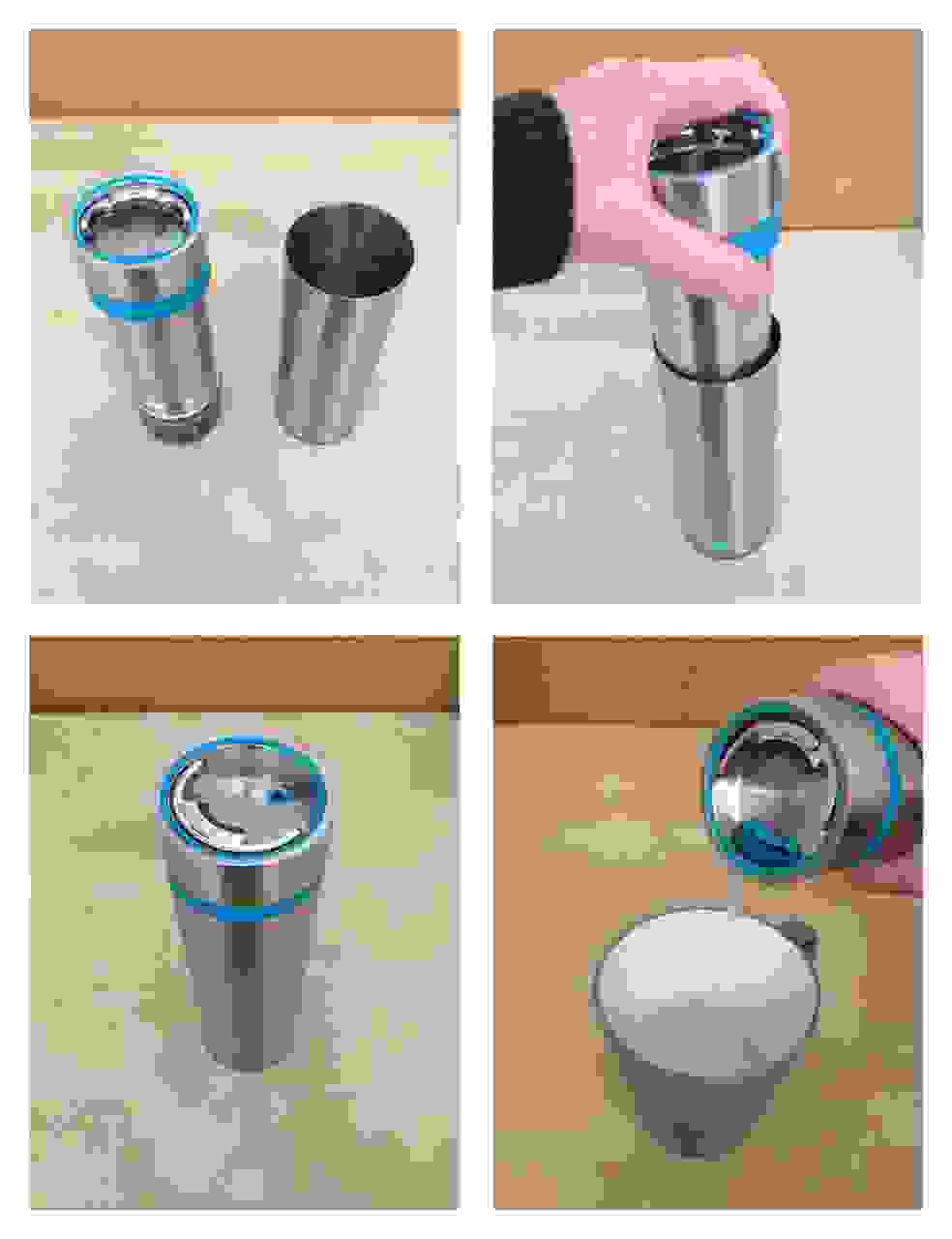
So it takes those extra 7 to 30 seconds (and maybe a little effort for the Travel filter) to get things going when you fill up, but that’s all you need to do until the next refill. And, as you can see, you can pour water from the bottle for friends, or fill up extra bottles for longer hikes where you won’t have access to more water. This is something most straw filter bottles just can’t do.
I can see certain situations where you might want a straw filter (biking, maybe), but this method allows for the convenience of no-suck drinking and pour-for-more-people functionality. Plus, you don’t have to drink from a sippy lid like a lil’ kid.
And just to compare the 30-second operation of the Travel filter with some other purification methods: UV lights take a minute, iodine tablets take half an hour, and others can take up to 4 hours.
One tip I’ll mention is that as you press the upper unit into the lower chamber, you have to keep it straight as you’re reaching the end. The upper unit can tilt a bit as you’re inserting it, and the lower unit can poke into the gasket if it’s tilting too much.
Drinking from the Grayl
I complain a lot about ease of use, as some of you may have seen in my pathologically-driven rant against every stupid water bottle on the planet, so I wanted to make sure the Grayl had a fairly simple locking mechanism that struck a nice balance between ease of use and security. Here’s how it works:
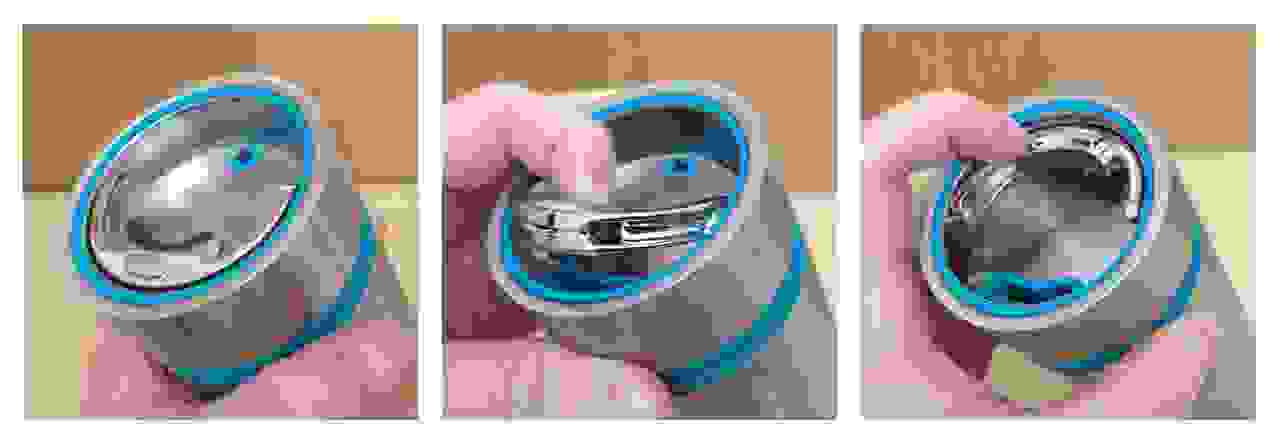
It’s quite simple. You push a button to release the lock, then flip the latch backward, where it clicks into place and releases a pressure valve, and then you drink. It’s not quite one-handed operation, but it’s very easy, and it’s positioned in a way that would make it quite difficult to open accidentally. I don’t expect I’ll need to stick a full water bottle into a backpack right next to a laptop, but I like having the option if necessary.
So I love the appearance, the simplicity of the filtration method, the option of the purifier, and the easy drinking mechanism. Plus, stainless steel is easy to wipe clean. It even fits in a car cup holder, and you can remove the filter and use it like a regular bottle, or remove just the lid, which allows you to fill it up without pressing the water through the filter, which is nice for people who already have clean water at home or the office.
It’s an all-around excellent design, which stacks up quite nicely against existing options. Which, at the moment, consist of just a few.
Other water purification bottles, aka the competition:
Though I’ve seen cheaper filters, they’re usually worse. Some don’t even filter bacteria. Just imagine the money you’d burn if you got sick and spent 3 days stuck in a hotel because you opted to save a bit on cheap filtration. And although good filters do exist (the Sawyer Water Bottle with Filter is an excellent filter-only bottle), they still won’t catch viruses. That might be okay at home or on the trail, but if you’re going anywhere with really questionable water, you really want better filtration.
I know of only a few other water filtration/purification bottles on the planet that can handle everything from large particles to the tiniest of viruses: The Katadyn MyBottle, which is similarly priced, but uses iodine to purify, thus affecting the taste; and the Lifesaver Bottle, which is a strong long-term investment if you’re planning on heavy use (it’ll become cost-effective after about 500 liters), but requires pumping to operate, which also makes it bigger and heavier. Both are worth a look, but the Grayl still compares quite nicely, whether on price or ease of use.
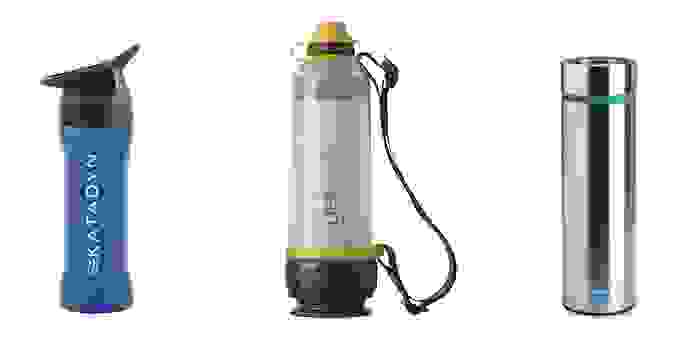
You can check out an in-depth comparison here (with a few updates as time has moved on).
But on a related note, part of the point of this whole thing was to design something that would not only filter water spectacularly well, but would also look classy at the same time. The Grayl was intended to work just as well at a business meeting as it does on the trail, instead of just being yet another sporty plastic water bottle. While you might shove all the others into a closet while at home, you might take the Grayl wherever you go.
But I also like the fact that I can mention its appearance as an afterthought. Its performance puts it on par with the best purifiers on the market, with cost-effectiveness comparable to long-time heavyweights like Katadyn, and its design eliminates the sucking, squeezing, pumping, and sippy straw operation of competing products. Even if you don’t care about aesthetics at all, it’s still one of the first things I’d recommend, especially since it can be your favorite water bottle at home, too.
Final Thoughts!
Anything I didn’t like?
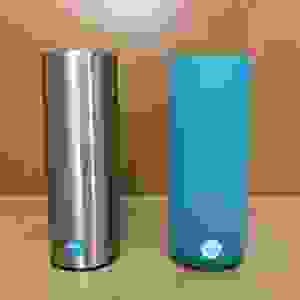
Well, I’ll mention the weight, which is about 20 oz (566 g) when empty, but there’s not much you can do if you want stainless steel construction, and besides, there’s now a lightweight option as well. Known as the Grayl Quest, it uses a plastic outer cup, reducing overall weight by about 20%, down to about 16 oz (453 g).
I’ve become quite attached to the stainless steel version, but ultralight minimalists might prefer the weight savings of the plastic. The pieces are interchangeable, so if you change your mind, you can replace the outer chamber without having to buy a whole new Grayl.
Update: As mentioned above, Grayl has launched the Grayl Ultralight, an all-plastic version that comes in at 10.9 ounces. If you’re backpacking, whether it’s the outdoorsy kind or the travel kind, that’s probably the one you want.
Though I expected the wide mouthpiece might cause some spills, this is rare. And I suppose the rubbery gasket that separates the upper and lower unit could be a little taller for added grip, but so far it feels fine.
It might be helpful to have some sort of attachment point, so you can hook it onto a bag, but I think that’s about it. Plans are already in the works for an accessory that’ll do that.
But it’s pretty tough finding fault with this thing, and these are definitely minor points. Overall, this’ll do it. It can be your one and only water bottle for whatever adventure comes your way. And it’s also nice to see that while other companies were sitting around for a decade not doing much of anything, these guys were working on something that could do it all, and look good, too.
Here they are, hard at work at the “office,” which is just whichever coffee shop they picked that week. They’ve really only just started.

Thanks once again to the Grayl team for letting me be one of the very first to try this thing. It’ll be going on all sorts of adventures with me.
Grayl specs and purchase info
-
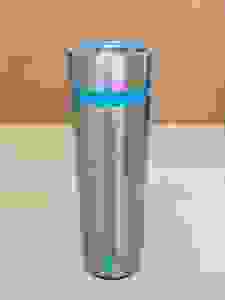
The Grayl, the silver bullet of water purifiers. No wait, NO! The Holy Grail! Dammit! Bottle price: $50-80 (plastic cup version), or $60-$90 (stainless steel cup version), with prices varying depending on the included filter unit of your choice.
- Replacement filters: $15 for the Tap filter, or $25 for the Purifier.
- Outer chamber replacements (if you decide to switch from plastic to steel, or vice versa): $12 for plastic, and $20 for stainless steel.
- Size: 9.1 x 2.8 in (23 x 7 cm)
- Weight: 16 oz (453 g) for the plastic version, and 20 oz (566 g) for the stainless steel version.
- Capacity: 16 oz (500 ml)
You can pick one up at TheGrayl.com.
As mentioned, they provided me with a free test sample, and, years after this review, made me a revenue-sharing offer as well, but I liked it long before then anyway.
Cheers.
Update! I just got back from a month in Guatemala, and didn’t buy water the whole time, using the Grayl (with the Travel unit, for the highest level of protection) to fill up from sinks and rivers, and it all worked out great. It came in especially handy on long hikes or late nights, with no open shops around.
A couple tips: I noticed that when you fly on a plane, the changes in air pressure can force the upper and lower chambers apart, causing a minor leak; I would recommend emptying it out completely before you fly, or filling it up all the way (since it’s just the air that expands or contracts) or just click it open while you’re in the air, to release the pressure, then close it again.
Also, the button on the latch eventually got a little stiff, making it more difficult to open, but scrubbing all over with a toothbrush fixed it right up. I expect it was just dust and grime that built up over time, so give this a try if you run into the same thing. Dropping a tiny droplet of cooking oil into the mechanism apparently works too.
All in all I’m quite happy with it!




Is there any metallic taste? I am on the lookout for a glass bottle filtration system. Just for filtering sink tap water. Trying to stay away from any plastics. This so far is the closest thing I can find.
Nope, no metallic taste. It tastes great. Noticeably better than regular tap water (and I live somewhere that has pretty good tap water). They do recommend you fill it up all the way and empty it out twice before you take your first sip, just to get rid of any factory dust, which is true of most bottles. Also, the plastic in the filter is BPA-free.
The alternative is to get a glass bottle, and just throw a carbon filter inside; these are basically just hunks of carbon you throw into a bottle like ice cubes, and they draw out the weird particles. Not a bad idea, but they can fall out, and might take a few minutes to draw everything out of the water, whereas passing water through a pressurized filter like the Grayl will mean that only water comes out the other side.
Hi ya
I just thought I.d drop you a line after reading so much on here about water filters and purification. I’m heading off on an 18 month rtw trip in 4 weeks to the far regions of the earth where all many of nasty things are in the water. It is incredibly hard finding a good filter and purifyer that filters viruses and chemicals. After much beleaguered searching I finally found the first need XL that does it all and is a pump that attaches to common nalgene or platypus packs etc. Its not exactly small but not huge either. It filters a large amount of water compared to most others with minimal hassle. It also filters radiation and chemicals as 1000 were sent to fukishima. Might be worth a look if you want an alternative to the fixed water bottle approach. Btw great site with lots of useful tips. Cheers :)
It seems like to push down the filter you’ll have to get your hands on the top / drinking area of the Grayl. Did you ever find this an issue when you were traveling? Or did you just make sure to use some hand sanitizer before you purified the water?
It also seems like you could get into a situation where the clean area gets dirty somehow (falls into a river, maybe?) then I guess you’d just have to wait until you got to a place with soap where you can clean the whole unit before you can use it again.
It’s something to keep in mind, yes; you can’t place your entire hand over the entire top of the upper unit, because you’ll get your hands all over the drinking area, so you need to press down over just the opposite half of it. It’s not so bad, though. You just have to press the right spot.
Also, the stainless steel is a lot easier to clean than silicone or other squishy materials. All you have to do is wipe with a damn cloth (and you can use the purified water from the Grayl to dampen it), whereas a silicone rubbery component usually takes some scrubbing to clean up. There’s a silicone seal in the Grayl, but it’s much smaller, and recessed, so it’s harder to get dirty.
While I was traveling in South America with it, I cleaned it up maybe once a week, either with a wet cloth, or if I really felt the need to get it clean, I used an alcohol swab, from the first aid kit. But I was also using a backpack that hid the water bottle in an interior pocket, so it didn’t get dusty the way it would if it were on an external pocket. So yes, these are potential issues, but I found them to be easily solvable. Every water bottle needs to be cleaned at some point, and cleaning this one is quite easy.
Thanks, I’ll be sure to carry some hand sanitizer. Despite the weight I think I’ll take the Grayl on my trip, though I’ll probably take a roll-up bottle to store water for the road. My friends are taking along Steripens, so I guess we’ll get to compare!
I like the stainless steel.
It appears that an O-ring or 2 is the only thing seperating contaminated water and uncontaminated water in this product.
A microsopic amount of contaminated water making it past the O-rings could potentially contaminate the purified water.
I often thought about water filter bottles that are dipped into the water. It seems like this untreated water on the outside of a bottle could infect you if accidently ingested, or cross contaminated the drinking contact area.
Also, I hate the 99.9% claims. Almost all water filter manufacturers claim this. I think the micron filtration specification is where the truth is found. There is alot of misinformation about the safe micron filtration specs and safety.
There is another micro filter outfit I stumbled across making claims that their filters have virus filtering ability, called rapidpure.
If you mean the silicone rubber ring on the filter unit, it has nothing to do with separating pure from impure water; it creates a seal between the inner and outer chambers, so water can’t escape out the outer chamber, but instead has to go through the filter, and into the inner chamber. There’s an additional silicone rubber ring on the filter unit that creates a seal between the filter and the inner chamber, but there’s actually a small plastic clip that needs to be clicked into place when it’s screwed into place tightly enough to create a seal, meaning it’s always going to be screwed into place tightly enough to create a seal.
Getting the outside of the bottle dirty and then somehow ingesting is a potential problem, but you’d really have to splash it around to get it near the drinking area. Obviously any amount of negligence is a problem, but that’s true of life in general, rather than a design issue. Any filter that needs to be placed into dirty water and is then removed will have some water on it afterwards. It’s just a matter of not drinking it.
Thanks for the response.
I like the Grayl travel.
Do you know if it is NSF 53 or 58 certified?
Do you know the filter media, and what the micron size is?
Neglegence. That is an interesting subject in itself, because drinking isnt the only potential exposure.
There is speculation that some people get sick from cross contamination even though they use proper filtration of water, after touching contaminated water and then food, etc, without cleaning hands. Which is a hygeine issue, but it is contamination from the same source.
Like the gravity bag style filters where you dip the bag in the water, then hang the bag. It would be easy for water to drip off the bag, or dowm the line and get into the clean water container, unless it is a closed system.
I have been reading about the Nano alumina filter technology that rapidpure, and Water-to-Go use.
The pore size, or chemicals isnt the mechanism that is used to eliminate the contaminants, as the rapidpure has a 1.75 micron size.
http://www.rapidpure.net/resources/RP%20Game%20Changer%20Doc%20Final.pdf
http://www.rapidpure.net/resources/RapidPure_Filters_Review-Backpacking_Light.pdf
http://www.watertogo.eu/filter-facts-3-w.asp
Drinksafe may have incorporated this technologty into their filters as well, on their technology page it says, “In 2010 integrated covalent bonding technology is built into each filter with biosafe media.”
The media doesn’t have a micron size, because it uses something called “adsorption,” which basically sucks the contaminants out of the water like a magnet. I haven’t checked the specific certifications; I just looked at the percentage of contaminants it removes, and the travel unit is obviously pretty great (it actually just uses a double wall of the same media; a single wall can remove viruses, but they wanted double the protection for cases in which you’d run into viral contamination).
For what it’s worth, I came across “Water-To-Go” which appears to use the same technology as the Grayl, but it’s from Europe: http://www.watertogo.eu/filter-facts-3-w.asp
It’s made of plastic so it’s lighter than the Grayl. It doesn’t use pressing but instead appears to use a straw.
Yeah, I was thinking of adding that to the list of water filters that can handle viruses, so I might get to it at some point…but actually they confirmed for me that it’s not the same technology as the Grayl…though it may have just been a misunderstanding, as they’re both NASA-developed and sound quite similar. But either way, it would definitely work.
Would you happen to know what the shelf life is on unused filters?
I usually like to stock up on filters just in case. I was reading that the Lifesaver only has a 3 year shelf life which is surprising. Thanks!
ARE THERE shares for sale lol
How do you know when to replace the filters?!! I’m interested in the Grayl but I’m confused….After you use the Travel version do you rinse it off then reuse?
The pressure builds up and it becomes harder to press the water through the filter, and then it needs to be replaced. This isn’t as easy as an auto-shutoff mechanism, so you have to pay attention to how difficult it’s becoming to use. And yes, I clean off the travel version, let it dry out, and store it somewhere for use again. I think as long as it dries out, it’ll be fine, though maybe before using it again, fill it up and pour out the water just to get rid of dust and things like that.
What do you think about the Clearly Filtered Athlete Edition Filtered Water Bottle 28oz, see: http://www.beyondhealthy.ca/shop/clearly-filtered-athlete-edition-filtered-water-bottle-28oz/ I would like to get one for travelling, but can’t figure out if it removes viruses from the water.
If they don’t mention it, then it doesn’t do anything about it. They’d brag about it if they had virus protection.
Do you have any experience with the NDUR bottles? They appear to filter damn near everything (including radioactive material) and they are priced fairly well.
For whatever reason, there are a lot of bottles out there that look exactly like the DrinkSafe Travel Tap (listed over here), and they all seem to be pretty similar…though I’m not entirely sure. I would almost assume they’re all using the same manufacturer and parts, but they may have differences. But, that being said, they certainly seem fine.
The NDUR bottle filters are from a company called Seychelle. They’re an American company, so those of us on this side of the pond will have more access. Also the radiation filtration is something I haven’t seen in other water filter companies. I would think folks traveling around any prior (or active) nuclear reactor sites would find this reassuring.
http://www.amazon.com/NDuR-Radiation-Replacement-Filter-System/dp/B008OG61ZU
Love this bottle. glad they came out with alternate plastic cover because as good as the stainless steal looks its a really heavy bottle. The other thing is the water gets a steel flavor to which is better then plastic but as much as i love this bottle. Its not perfect
Enjoyed this post, Snarky Nomad. Which filter do you use now?
I’m using the Grayl Ultralight, which is great. It’s about half the weight of this one, and that was the only potential problem with it.